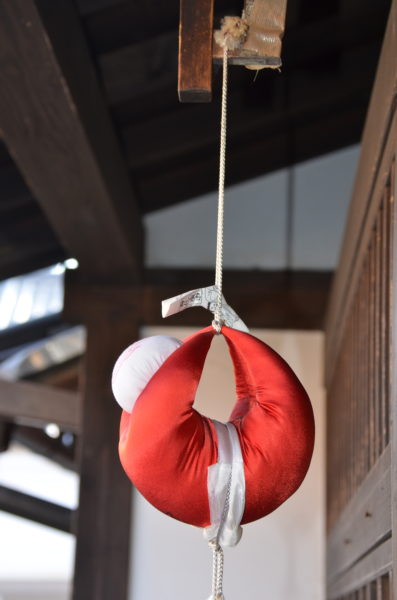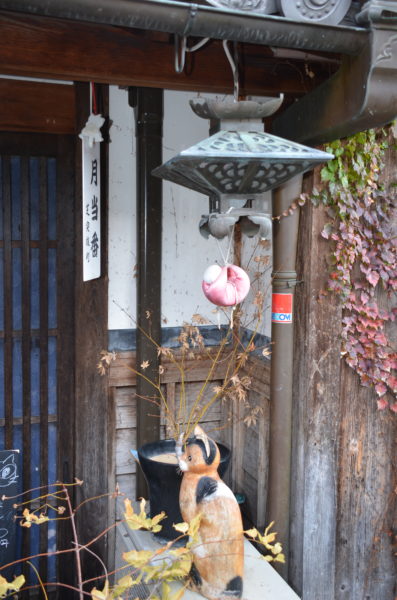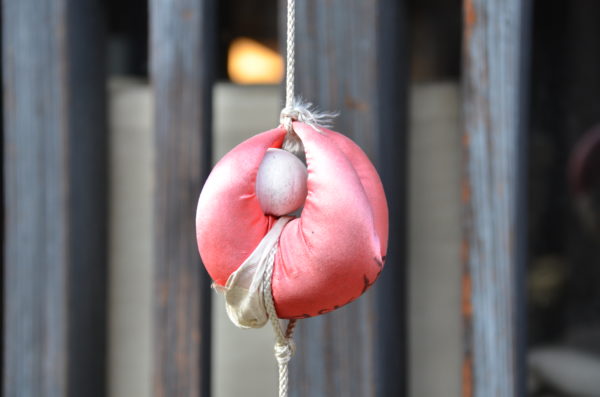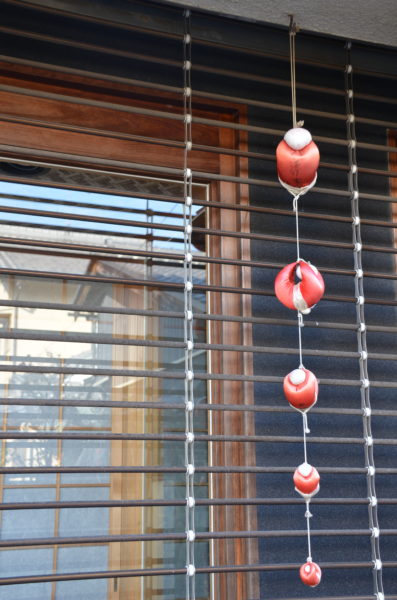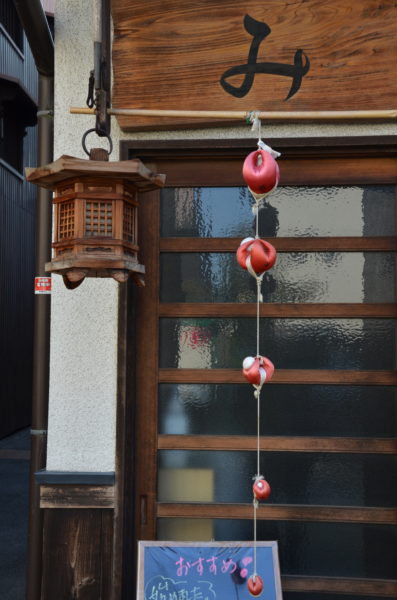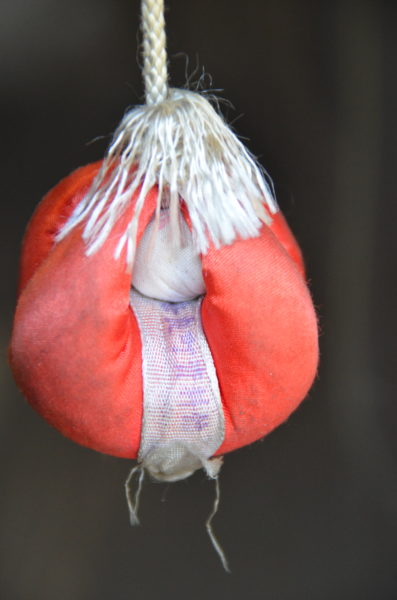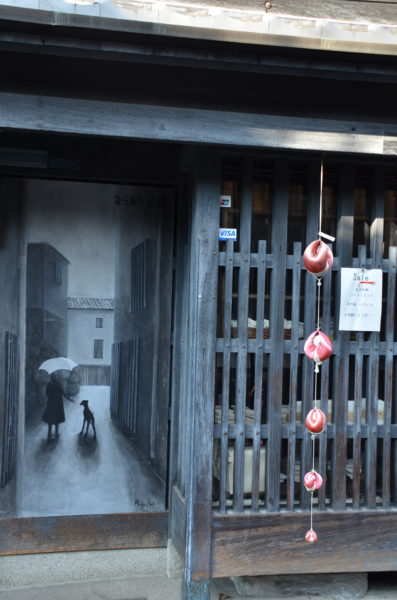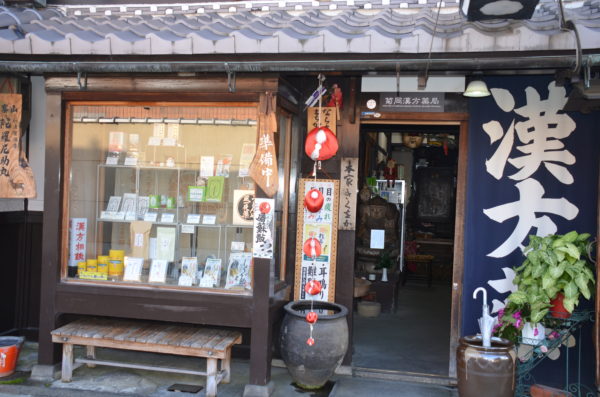« Les charmes japonais des « Migawari-zaru »
Pour un premier voyage au Japon, une escale à Nara m’était apparue comme une étape salutaire pour prendre le pouls d’un pays si lointain, me repérer dans l’espace sans maîtriser la langue ou me perdre dans le plus grand temple en bois du monde.
Au cours de cette étape destinée à retrouver un peu de sérénité, j’ai très vite découvert au cœur de Nara de petites boules de tissu rouge et blanc se balançant au gré du vent, souvent en groupes, devant les maisons traditionnelles du quartier de Naramachi. Dans ces rues impeccablement tenues, devant ces façades parfaitement alignées et ces micro jardins minutieusement soignés, ces petits personnages semblent très discrètement transgresser les règles : de tailles irrégulières, de nombres différents et décorées d’inscriptions variées, elles constituent des bulles de fantaisie, de légèreté et de poésie.
Tout près d’Osaka, à 42 km au sud de Kyoto, Nara transmet irrésistiblement au visiteur l’âme du vieux Japon : en 710 (et pour 74 ans) Nara fut en effet la capitale de ce pays (avant Kyoto puis l’actuelle Tokyo). A cette époque, artistes, savants et techniciens viennent de Chine et de Corée enseigner le tissage de la soie, la maîtrise de la laque ou l’architecture. Le temple Gango-ji serait le premier temple bouddhique du Japon et c’est autour de lui que s’étendent les petites rues paisibles du quartier Naramachi. Les maisons datent pour la plupart de la période d’Edo (1600-1868) ou ont été reconstituées à l’identique : ce sont des « Machiya », longues maisons de bois, à la façade étroite, à la fois magasin ou atelier et lieu d’habitation.
Ce sont sur ces façades traditionnelles que sont suspendus les « Migawari-zaru », littéralement « singes de substitution ». Des façades à grilles qui dissimulent de l’extérieur et laissent voir de l’intérieur. Ces figurines de satin rouge ont pour mission de protéger les habitants de la maison, de la maladie et du malheur et d’empêcher le diable de pénétrer dans la demeure. Leur nombre équivaut au nombre de membres de la famille. Pourquoi évoquer la figure du singe ? Sans doute parce que dans le calendrier lunaire, lors des « Kooshin-days » du singe, les trois vers censés habiter le corps humain s’échappaient pour aller rapporter à la divinité les péchés commis par la personne. Kooshin était alors une divinité qui protégeait ceux qui auraient dû être punis par les dieux et c’est un singe, son messager, qui était alors puni à la place du pécheur.
Dans un pays où les hautes technologies semblent si bien intégrées, ou la courtoisie ne semble pas entraver la prospérité économique, mon œil de photographe a été irrésistiblement attiré par ces personnages ou singes, dans tous les cas porte-bonheur, qui défient en toute innocence le raisonnable et le cartésien. Un voeu sur un morceau de papier ou omikuji, une promesse sur une ceinture ou une prière griffonnée sur la tête : il n’en fallait pas plus pour me faire rêver et souhaiter vous emmener sur ce chemin de poésie.
« The Japanese charms of the » Migawari-zaru «
« The Japanese charms of the » Migawari-zaru «
For a first trip to Japan, a stopover in Nara appeared to me as a salutary step to take the pulse of a country so far away, to locate me in space when I do not master the language.
I quickly discovered in the heart of Nara small balls of red and white fabric swinging in the wind, often in groups, in front of the traditional houses in the district of Naramachi . In these impeccably kept streets, in front of these perfectly aligned facades and meticulously tended micro-gardens, these little figures seem to be very discreetly transgressing the rules: irregular sizes, different numbers and decorated with various inscriptions, they constitute bubbles of fantasy, Lightness and poetry.
42 km south of Kyoto, Nara transmits irresistibly to the visitor the soul of old Japan: in 710 (and for 74 years) Nara was in fact the capital of this country (before Kyoto and the current one Tokyo). At that time, artists, scholars and technicians came from China and Korea to teach the weaving of silk, the mastery of lacquer or architecture. The Gango-ji Temple is the first Buddhist temple in Japan, and the small and peaceful streets of the Naramachi district lie around it. The houses mostly date from the Edo period (1600-1868) or were reconstituted identically: they are Machiya, long wooden houses with narrow facades, both shop or workshop and dwelling place.
It is on these traditional facades that are suspended the « Migawari-zaru », literally « substitute monkeys ». Facades with grids that conceal from the outside and allow to see from the inside. These red satin figurines have the mission to protect the inhabitants of the house, illness and misfortune and to prevent the devil from entering the house. Their number is equal to the number of family members. Why evoke the figure of the monkey? No doubt because in the lunar calendar, during the « Kooshin-days » of the monkey, the three verses supposed to inhabit the human body escaped to go back to the deity the sins committed by the person. Kooshin was then a divinity who protected those who should have been punished by the gods, and it was an ape, his messenger, who was then punished in the place of the sinner.
In a country where high technologies seem so well integrated, or courtesy does not seem to hinder economic prosperity, my eye photographer has been irresistibly attracted to these characters or monkeys, in all cases lucky charm, which defy in all innocence The sensible and the Cartesian. A vow on a piece of paper or omikuji, a promise on a belt or a prayer scribbled on the head: it took no more to make me dream and wish to take you along this path of poetry.

